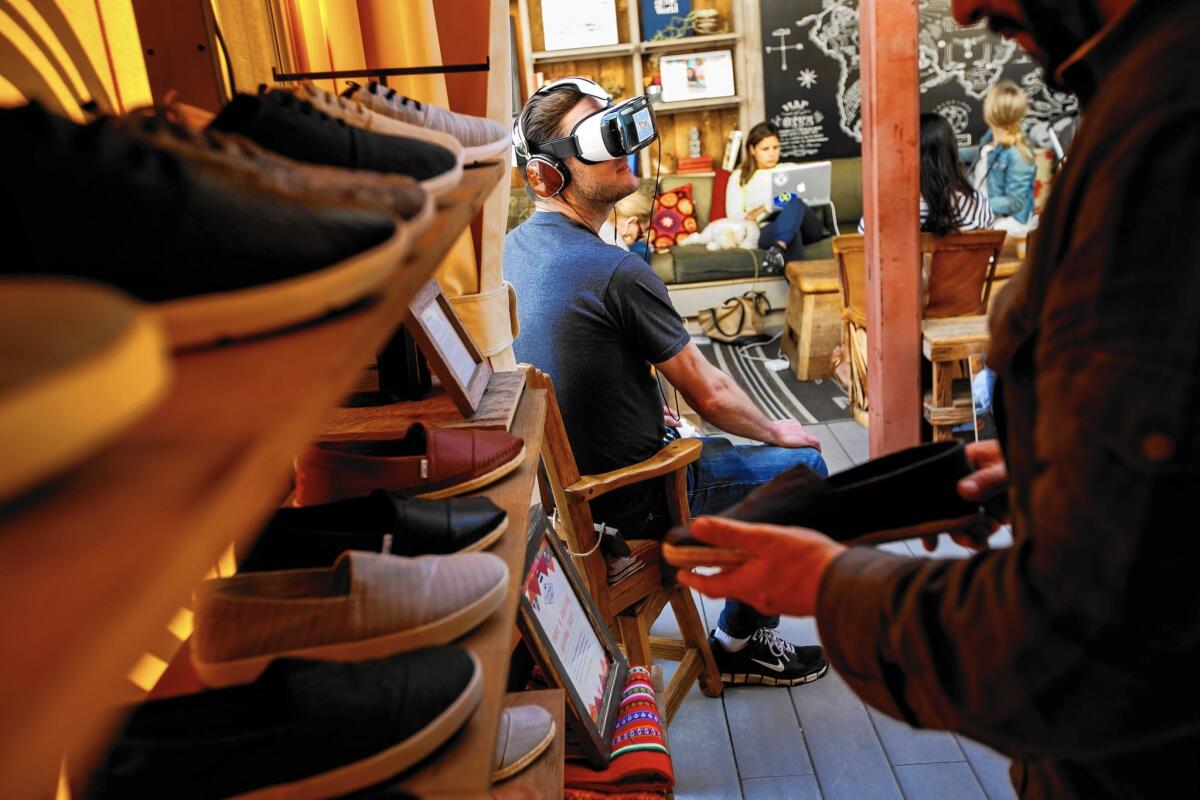How retail stores are using virtual reality to make shopping more fun

- Share via
The next item you try on at the mall might be a virtual reality headset.
No longer relegated to video gamers, VR is coming to amusement parks, movie theaters and classrooms. But the technology presents a major opportunity for retailers as they try to lure fickle shoppers into their stores, particularly as consumers shift more of their buying habits online.
Already, Ikea, Lowe’s, Toms and North Face are turning to virtual reality to sell products, boost their brands and make shopping more fun.
“Virtual reality is going to fundamentally transform the human experience of shopping,” a report from digital agency SapientNitro said, predicting that it would “lift sales for those retailers who get ahead of the curve.”
Lowe’s has added a futuristic edge to the often teeth-gnashing process of remodeling a kitchen or bathroom.
In 19 stores around the country — though none in California — the home improvement chain has installed a space that enables shoppers to see a 3-D mock-up of their renovation plans.
Called the Holoroom, the simulated space can be personalized with individual room sizes, equipment, colors and finishings. Shoppers can give Lowe’s the dimensions of a room and fill it from a selection of thousands of Lowe’s products.
Then they slip on an Oculus Rift virtual reality headset to look at how all the elements play together (an employee can switch out parts of the room while the customer is still looking). The design is also viewable at home on YouTube 360 with a Google Cardboard viewer, which Lowe’s gives out free through on-site vending machines.
Kyle Nel, executive director of Lowe’s Innovation Labs, said the Holoroom helps nudge people over the biggest hurdle when it comes to a room refresh: imagining what those changes will look like in real life.
“If you think about the way people conceptualize remodels now, it’s really abstract,” Nel said. “They go and get a little swatch here and one there and lay it on a table.”
But with virtual reality, people can get a much more “holistic” and immersive view of how a slab of marble or different paint color can change an entire room — drastically increasing the likelihood that they will go with Lowe’s for their project, Nel said.
“It removes five steps along the way,” he said. “Anyone who has done a renovation has a really visceral reaction.”
Virtual reality headsets mimic the sights and sounds you find in the real world, using a combination of motion-tracking, graphics and algorithms. The next step for Lowe’s is incorporating Microsoft HoloLens and Google’s Project Tango, where virtual objects can be overlaid on top of real objects.
“You can stand in your own kitchen and overlay a fridge on top of your own fridge,” Nel said. “It’s uncannily real.”
Although the virtual reality industry is still in the early stages, its annual revenue is forecasted to grow from less than $1 billion to $30 billion by 2020, according to advisory firm Digi-Capital. Annual sales of headsets could hit half a billion by 2025, Piper Jaffray predicts.
Down the line, as virtual reality becomes more mainstream and consumers buy their own headsets, much of so-called v-commerce could move away from stores and into the home. That means you could walk through a store and browse for new jeans — all without leaving your couch.
But analysts say companies have to be smart about deploying virtual reality so that it’s brand-relevant and doesn’t feel gimmicky.
Virtual reality is also being used to add an experiential aspect to in-store shopping, unrelated to the actual buying of products. Retailers are dabbling in virtual reality for the same reason they are adding other conveniences like curbside pickup — to lure people back into stores. They figure that the sci-fi aspect of VR is a form of entertainment that can’t be replicated from behind a computer screen.
“Retailers have been down for so long, they have got to differentiate themselves to get people to shop,” said Ron Friedman, a retail expert at advisory and accounting firm Marcum in Los Angeles.
Toms, which started as a shoe company before branching into eyewear and coffee, put virtual reality headsets from Samsung into more than 100 stores around the world last year. The video shown depicts a trip to Peru as part of the company’s popular one-for-one campaign, in which it donates a pair of shoes for every pair it sells; viewers can see a video with panoramic views of a schoolyard as children are handed boxes of shoes.
On a recent weekday, Tyler Costin, 32, slipped on a Samsung Gear VR headset while shopping at the Toms store on Abbot Kinney Boulevard in Venice.
“That’s amazing,” he said, swiveling in his chair to take in the 360-degree views. At one point, Costin lifted his hand to greet the students before quickly putting it back down. “You want to wave back,” he said sheepishly.
The Westwood producer, who had never used a VR headset before, said the experience was “pretty incredible.”
“It’s like you’re there,” Costin said, joking that “Peru was lovely that time of the year.”
That kind of immediacy is why virtual reality trumps photographs and traditional videos, Toms founder Blake Mycoskie said.
“It just touches more of your senses,” Mycoskie said. “It gives you a more immersive experience — you really get the feel of motion.”
Sensory drama doesn’t come cheap. Filming was about $250,000, and outfitting each store costs about $1,000 each, Mycoskie said. The biggest expense was training at least one employee per shop to operate the equipment and walk shoppers through the process.
But Mycoskie said virtual reality is worth it. Toms, he said, is in the middle of editing a second virtual reality video that will debut in May.
“There is so much e-commerce today, you have to come up with a new reason to go to stores,” he said.
Outdoor recreation brand North Face rolled out two virtual reality videos last year. Three of its stores currently have VR headsets, including a location in San Francisco.
The first video, which debuted in March 2015, featured rock climbing in Yosemite and the Moab Desert in Utah. For the second, the Alameda, Calif., company partnered with Outside magazine to issue Google Cardboard to subscribers so they could view shots of Nepal on their smartphones.
Todd Spaletto, president of North Face, said virtual reality was a good way to bring the wilderness inside.
These videos “let people see the beauty of these places,” he wrote in an email. It’s “one unique way we can introduce and encourage people to get outside.”
Adding a virtual reality component to stores could especially be a draw to millennial shoppers, who are tech-savvy and even more inclined to do all their buying online, Friedman said.
Although much of retail VR is currently taking place in stores, Ikea launched an app last week so people who own a HTC Vive headset can look inside a virtual kitchen. You can poke inside drawers and change the color of cabinets.
But some experts say these kinds of practical applications will be few and far between. Most retailers will seize on virtual reality for the gimmicky dazzle factor, said Sucharita Mulpuru, a retail analyst at Forrester Research.
Mulpuru said the gear that is required makes virtual reality unattainable for many consumers. Most VR headsets are still expensive. The HTC Vive headset is priced at $799 and the Oculus Rift costs $599. More affordable versions include the Samsung Gear VR, priced at $99, and the Google Cardboard, which costs $15.
“Unless VR devices come down in price and are widely accessible,” she added, “the truth is you can probably get a good enough way of simulating something just with photography.”
Useful or not, many companies are rushing to cash in on the virtual reality gold rush.
Two Bit Circus, a Los Angeles firm that helps companies throw tech-infused events, opened a virtual reality division in January, said Nancy Bennett, the chief content officer.
The company helped Verizon create a virtual reality project for last year’s Super Bowl, where people got a taste of playing in a NFL game. That simulation is now in the Verizon store at the Third Street Promenade in Santa Monica.
Twitter: @ByShanLi
ALSO
Millennials are better than we thought at saving money, studies find
Why Silicon Valley venture capital firms are funding online retailers like Dollar Shave Club
Big investments in Potter world and other attractions will pay off for the Southland economy
More to Read
Inside the business of entertainment
The Wide Shot brings you news, analysis and insights on everything from streaming wars to production — and what it all means for the future.
You may occasionally receive promotional content from the Los Angeles Times.











